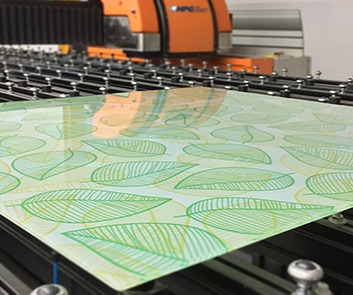High Performance Glazing digital printing process is a technology that applies ceramic ink directly onto glass in much the same way that an inkjet printer prints onto paper. Ceramic frit designs are fused on to the glass surface during the tempering process.
Digital printing on glass can enhance its uses and value, expanding the possibilities for surface designs that are both beautiful and functional, and for a wide variety of applications.
This versatile product can be applied to glass for a cost effective, low maintenance solution to many design needs. Our Glass products are manufactured with digital ceramic printing which make them highly durable, abrasion-resistant, available in a wide variety of colors and patterns. All of the digital glass printing products are available in laminated, monolithic or insulated form.
Digital glass printing using the ceramic technology is a considerably different approach to using digital UV. With digital ceramic printing, the ink used contains ceramic frit (these are Nanoparticles of glass mixed with colored pigments) and are fused into the glass after tempering. As a result, the ink becomes an integral part of the printed glass. In comparison, digital UV inks are not fused into the glass; rather they are laid down on top of the glass and then cured, creating an ultra-thin printed layer over the glass surface. When comparing the two options, we find that Digital Glass Printing using ceramic technology is the most effective and highest quality method.

Common Applications for Digital Glass Printing
Glass railing
Bird Friendly Glass
Custom laminated glass
Tabletops
Signage
Divider/Partition glass
Kitchen backsplashes
Insulated units
Bus Shelter, Canopies, Boats
Public art
Spandrel
Any architectural project that can be imagined
Features & Benefits of Digital Glass Printing
Highly durable, long lasting, and abrasion resistant.
Available in a wide range of colors and patterns.
May also be recycled at the end of its useful life.
Available in laminated, monolithic form and as an insulated unit
Can be used as a way of controlling the solar heat gain into a building.
Opening new opportunities for the glass industry
By combining the flexibility and high-quality of digital glass printing with the durability of ceramic inks, digital ceramic printing has created new opportunities for glass manufacturers and architects to offer glass printing services that were previously not utilized. These methods were often not considered because of the earlier technology limitations and costs of production.
Ceramic Glass Printing technology enables a high degree of customization, which creates printed glass designs that are extremely durable and resistant to internal and external conditions. With digital ceramic printing on glass, glass fabricators can print any design their architect and interior designer clients might imagine, on panels of almost any size with complete predictability, repeatability, and accurate color matching.
Digital ceramic printing on glass also supports a wide range of functional requirements, meeting the needs of architects and interior designers to integrate functional performance into the glass elements of their designs. With ceramic inks, numerous performance factors can be achieved and controlled, including light diffusion, light transmission, energy efficiency, shading control, slip-resistance and privacy levels. In addition, digitally printed glass is a recyclable and non-toxic material when using inks that are free of toxic heavy metals, thus offering a sustainability advantage that is an increasingly important consideration in many architectural projects.
Digital ceramic printing on glass also eliminates the typical constraints of traditional screen printing and UV digital printing. The process does not require screens which can be costly, and the files are stored digitally. Therefore, there are no setup, storage, or maintenance costs. And, compared to UV digital printing, digital ceramic printing offers longer durability, enabling more exterior applications.







Great article!